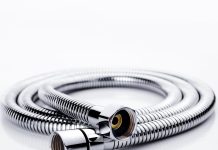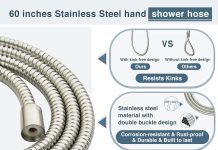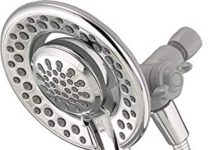Hey there! Ever wondered if all shower heads fit the same hose? Well, we’ve got you covered with some handy information. Whether you’re replacing a broken shower head or just exploring different options, it’s important to know if you can use your existing hose. So, let’s dive into the world of shower heads and find out if they all play well with the same hose!
Table of Contents
Different Types of Shower Heads
When it comes to shower heads, there are several different types to choose from, each offering a unique showering experience. Let’s explore some of the most common types of shower heads available on the market today.
Fixed Shower Heads
Fixed shower heads, also known as wall-mounted shower heads, are the most traditional and commonly used type of shower head. As the name suggests, these shower heads are fixed to the wall and provide a steady stream of water. They usually have adjustable settings to control the water pressure and spray patterns.
Handheld Shower Heads
Handheld shower heads offer a lot of flexibility and convenience. They consist of a detachable shower head that can be held in your hand, allowing you to direct the water wherever you need it. This is particularly useful for individuals with limited mobility or for cleaning the shower stall. Handheld shower heads often come with a hose, which allows for easy maneuverability.
Rainfall Shower Heads
If you’re looking for a luxurious showering experience, a rainfall shower head might be just what you need. These shower heads are designed to simulate the sensation of standing in the rain, with a wide stream of water that cascades down from above. Rainfall shower heads are typically larger in size and are installed directly overhead or on the ceiling to create a relaxing and immersive showering experience.
Dual Shower Heads
For those who enjoy the best of both worlds, dual shower heads provide the ultimate showering experience. These innovative shower heads feature two separate shower heads on a single fixture, with each head offering its own water flow and settings. Dual shower heads are perfect for couples or anyone who wants to customize their shower experience.
Components of a Shower Head
To understand how a shower head works, it’s essential to familiarize yourself with its components. Let’s take a closer look at the various parts that make up a typical shower head.
Spray Nozzle
The spray nozzle is the part of the shower head that releases the water. It consists of multiple small holes or jets that disperse water in various patterns and intensities. The design of the spray nozzle directly affects the water flow and pressure, allowing for different showering experiences.
Faceplate
The faceplate is the front part of the shower head that covers the internal workings. It often features decorative elements and may have adjustable settings for controlling the water flow and spray patterns. The faceplate can be made of various materials, including metal or plastic, depending on the shower head model.
Swivel Ball
The swivel ball is a small component that connects the shower head to the shower arm. It allows for easy rotation and tilting of the shower head, enabling you to adjust the direction of the water flow. The swivel ball is typically made of durable materials, such as brass or stainless steel, to ensure smooth and long-lasting movement.
Flow Control Valve
The flow control valve is responsible for regulating the amount of water that flows through the shower head. It allows you to adjust the water pressure to your desired level. Some shower heads have a built-in flow control valve, while others may require the installation of an external valve.
Rubber Washer
The rubber washer is a small but crucial component that helps create a watertight seal between the shower head and the shower arm. It prevents water from leaking and ensures that the water flows steadily through the shower head. Rubber washers should be periodically checked and replaced if worn out to maintain optimal performance.
Standard Hose Sizes
Shower heads are typically connected to the water source using a hose. It’s essential to select the right hose size to ensure proper compatibility and functionality. Here are some of the most common standard hose sizes used for shower heads.
1/2-inch Hose
The 1/2-inch hose is the most common size used for shower heads. Most shower heads come with a 1/2-inch connection, making it easy to find hoses that fit. This size is suitable for most household showers and provides a good balance between water flow and pressure.
3/8-inch Hose
The 3/8-inch hose is a less common size used for shower heads. It is primarily used in specific shower head models that require a smaller connection. If your shower head has a 3/8-inch connection, make sure to choose a hose with a matching size to ensure a proper fit.
3/4-inch Hose
The 3/4-inch hose is a larger size typically used for industrial or commercial applications. It provides a higher water flow rate but is not commonly found in residential showers. Unless you have a specific need for a 3/4-inch hose, it is unlikely that you will encounter this size when purchasing a shower head for your home.
Types of Hose Connectors
In addition to hose sizes, it’s essential to consider the type of connector used to attach the hose to the shower head. Different types of hose connectors offer varying levels of convenience and ease of use. Let’s explore some of the most common types of hose connectors for shower heads.
Threaded Connectors
Threaded connectors are the most traditional type of hose connectors. They consist of two threaded parts that screw together to create a secure connection. Threaded connectors often require the use of a wrench or pliers to tighten properly. While they offer a reliable and sturdy connection, they can be more challenging to install or remove compared to other connector types.
Quick Connectors
Quick connectors, also known as snap-on connectors, provide a hassle-free way to attach and detach the hose to the shower head. They feature a simple push-and-lock mechanism that allows for quick and easy installation. Quick connectors are especially popular for handheld shower heads, as they provide effortless detachment for versatile use.
Push-Fit Connectors
Push-fit connectors are another user-friendly option for connecting hoses to shower heads. They feature a push-in design, where the hose is inserted into the connector and securely held in place. Push-fit connectors are typically made of plastic and offer a reliable, leak-free connection. They are particularly suitable for DIY installations, as no additional tools are required.
Compression Connectors
Compression connectors are a type of hose connector that requires a compression nut to secure the connection. The nut is tightened over a compression sleeve, creating a watertight seal. Compression connectors offer a reliable and sturdy connection, making them suitable for high-pressure applications. However, they may be more challenging to install and require additional tools.
Compatibility of Shower Heads and Hoses
Before purchasing a new shower head, it’s essential to consider the compatibility between the shower head and the hose. Ensuring a proper fit will save you time, money, and frustration. Let’s explore the different types of compatibility between shower heads and hoses.
Universal Fit
Some shower heads and hoses are designed with a universal fit, meaning they are compatible with a wide range of shower heads and hoses. This universal compatibility allows for easy replacement or upgrade without the need for additional adapters or connectors. When purchasing a new shower head, look for the “universal fit” label or consult the manufacturer’s specifications to ensure compatibility.
Manufacturer-Specific Fit
Certain shower head models are designed to be used exclusively with hoses from the same manufacturer. These manufacturer-specific fittings ensure a secure and leak-free connection but can limit your options when it comes to selecting a new shower head. If you have a manufacturer-specific hose, it’s best to choose a replacement shower head from the same manufacturer or consult their recommendations for compatible options.
Interchangeable Fit
Some shower heads and hoses feature interchangeable fittings, allowing you to mix and match different brands and models. These fittings often use standard sizes or universal connectors that make it easy to swap components. If you prefer the freedom to customize your shower head setup, look for shower heads and hoses with interchangeable fittings.
Factors Affecting Compatibility
Several factors can affect the compatibility between a shower head and a hose. Understanding these factors will help you make an informed decision when selecting a new shower head or hose.
Hose Size
As mentioned earlier, hose size is a critical factor in determining compatibility. Ensure that the hose size matches the connections on both the shower head and the water source. Using a hose with the wrong size can result in leaks, poor water flow, or damage to the shower head or water supply.
Connector Type
The connector type on the shower head and hose should match to ensure a proper fit. Consider the type of connector used by the shower head and the hose, whether it’s threaded, quick connect, push-fit, or compression. If the connector types do not match, adapters or converters may be required to create a compatible connection.
Design of Shower Head
The design of the shower head, including the shape and mounting method, can also impact compatibility. For example, some shower heads require specific mounting brackets or fixtures to install correctly. Before purchasing a new shower head, ensure that it is compatible with your existing shower arm or mounting setup.
Adapters and Converters
In cases where a shower head and hose have incompatible fittings, adapters and converters can be used to create a compatible connection. These accessories bridge the gap between different connector types or sizes and allow for a proper fit. Let’s explore some common adapters and converters used for shower heads.
Hose-to-Hose Adapter
A hose-to-hose adapter is used when you need to connect two hoses of different sizes or connector types. This adapter allows you to join two hoses together, extending the overall length or creating a compatible connection. Hose-to-hose adapters come in various sizes and connector types, so ensure that you choose the correct one for your specific needs.
Hose-to-Shower-Head Adapter
A hose-to-shower-head adapter is used when you have a hose with one type of connector and a shower head with a different type of connector. This adapter allows for a seamless connection between the hose and the shower head. Just like hose-to-hose adapters, ensure that you select the appropriate size and connector type for your specific setup.
Hose Size Converter
If you have a hose with the correct connector type but the wrong size, a hose size converter can come in handy. This converter allows you to adapt a hose with one size to fit a shower head with a different-sized connection. For example, if you have a 3/8-inch hose and a shower head with a 1/2-inch connection, a hose size converter can bridge the gap and provide a compatible fit.
Replacing a Shower Head
Replacing a shower head is a relatively simple process that requires minimal tools and expertise. Here’s a step-by-step guide on how to replace a shower head.
Choosing a Compatible Replacement
Before removing the old shower head, ensure that you have a compatible replacement on hand. Consider the hose size, connector type, and compatibility factors discussed earlier to find a suitable replacement shower head. Take measurements if necessary and consult the manufacturer’s specifications or customer service for assistance.
Removing the Old Shower Head
To remove the old shower head, start by turning off the water supply to your shower. Use an adjustable wrench or pliers to loosen the connection between the shower head and the shower arm. Turn the shower head counterclockwise until it comes off completely. Be careful not to damage the shower arm or surrounding fixtures during this process.
Installing the New Shower Head
Begin by cleaning the threads of the shower arm to ensure a clean and secure connection. Apply plumber’s tape, also known as Teflon tape, to the threaded part of the shower arm to create a watertight seal. This helps prevent leaks and ensures a snug fit. Next, screw the new shower head onto the shower arm, turning it clockwise until it is securely tightened. Use an adjustable wrench or pliers if necessary, being careful not to overtighten and damage the shower head.
Considerations When Purchasing a New Shower Head
When shopping for a new shower head, there are a few important considerations to keep in mind to ensure a successful purchase and installation.
Checking Compatibility
As mentioned earlier, compatibility is crucial when selecting a new shower head. Consider the hose size, connector type, and compatibility factors discussed earlier to ensure a proper fit between the shower head and your existing setup. Look for information on compatibility provided by the manufacturer or consult their customer service for assistance.
Consulting Manufacturer Information
Manufacturers often provide detailed specifications, installation guides, and compatibility information for their shower heads. Take the time to read through the product descriptions and instructions to ensure that the shower head you are considering will meet your needs and be compatible with your existing setup. Manufacturer websites and customer service can be valuable resources for obtaining further information.
Seeking Professional Advice
If you’re unsure about the compatibility or installation of a shower head, it’s always a good idea to seek professional advice. Plumbing professionals or experienced contractors can provide guidance on selecting the right shower head, ensure a proper installation, and address any specific concerns or requirements you may have.
Conclusion
When it comes to shower heads, understanding compatibility is vital for a successful and enjoyable showering experience. Consider the different types of shower heads available, the components that make up a shower head, and the factors that affect compatibility with hoses. Choose the appropriate hose size and connector type, and don’t forget to consider the design of the shower head itself. If needed, adapters and converters can help create a compatible connection. Replacing a shower head is a straightforward process, but it’s essential to choose a compatible replacement and follow proper installation steps. By considering these factors and seeking professional advice when needed, you can find the perfect shower head for your needs and enjoy a refreshing and invigorating shower every time.






















